#Badumna
Text

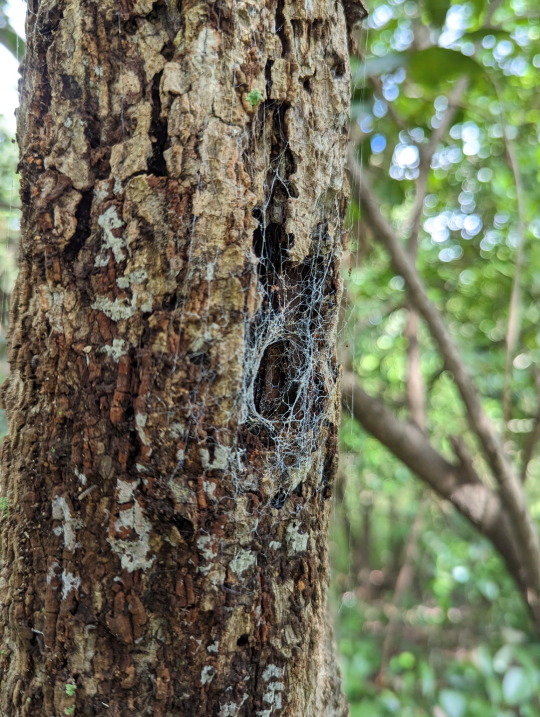
House Spider Web
Unidentified, genus Badumna
24/03/23 - NSW, Dapto
#invertebrates#invertblr#Arthropods#Arthropoda#bugblr#bugs#bug#bugs tw#Badumna#unidentified#House Spiders#spiders#spiders tw#webs#Desidae#Araneae#Arachnida#arachnids#aracnophobia#Chelicerata#Chelicerates
31 notes
·
View notes
Photo
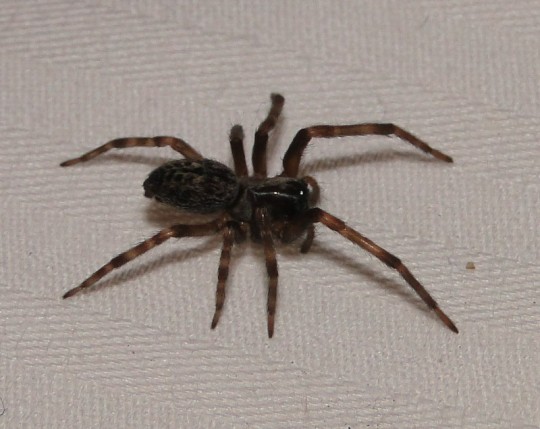
@lishd submitted: Here's a polite grey house spider (I think?) that I met shortly after arriving to New Zealand. Specifically, I found him on my neck. Hence the politeness. :)
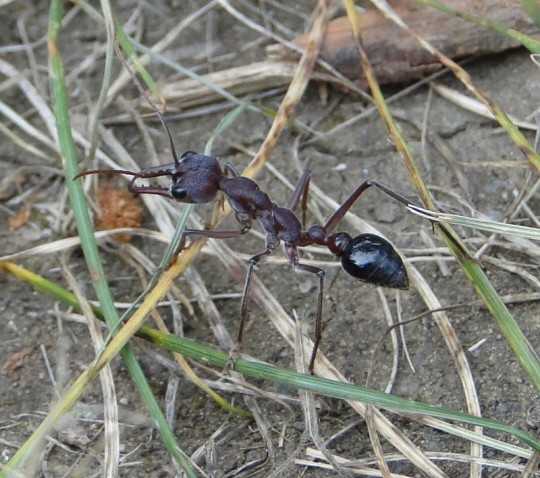
And the bulldog ant I found in Australia. He was almost an inch long and used his giant mandibles to steal my heart. ^_^
Yes sure looks like a grey house spider! Or one of the house spiders in the genus Badumna, at any rate. THAT ANT THO. They have stolen my heart with their enormous mandibles too. I am mentally giving them a little smooch...
112 notes
·
View notes
Text
#2088 - Badumna sp.

Really not sure which species this is - te two most common Badumna in Australia are longiqua and insignis, both of whom are common around houses, but this is neither.
Mt. Ainsley, ACT
0 notes
Photo

🕷️🕸️ ¡Qué patrón de telaraña tan inusual e interesante! Este es un patrón típico de las arañas Paramatachia. Otras arañas de la misma familia (Desidae) también hacen telarañas similares, como Badumna y Matachia. Todas se pueden encontrar en Australia/Nueva Zelanda; se supone que la imagen fue tomada en Tasmania. Crédito: M. Hedin. — view on Instagram https://ift.tt/l5UPuVf
22 notes
·
View notes
Note
i think it might be a grey house spider, if that helps!
First of all I explicitly said no cheating, second of all, I've gone over that option alongside the black house spider (Badumna insignis), and my issue is that while it does look a lot like a insignis, those aren't found in flordia to my knowledge. Longinqua is found in flordia, but all the other photos I've found of it show some sort of banding on the legs and I just don't see that in Dream's photo. I'm leaning towards some species of Amaurobiidae or Desidae, the two are hard to tell apart and have had species flop around between them. Still haven't reached my final conclusion. May need several days to think about spiders.
20 notes
·
View notes
Text
Badumna longinqua
Lostafew #dontlimp
4 notes
·
View notes
Text

🕷️🕸️ ¡Qué patrón de telaraña tan inusual e interesante! Este es un patrón típico de las arañas Paramatachia. Otras arañas de la misma familia (Desidae) también hacen telarañas similares, como Badumna y Matachia. Todas se pueden encontrar en Australia/Nueva Zelanda; se supone que la imagen fue tomada en Tasmania.
Crédito: M. Hedin.
2 notes
·
View notes
Text
U-193-x-014
Ballpoint on paper
2020
218 x 358mm
Badumna insignis (black house spider)
Part of my open series 'u-193-x' aka 'The End Was Nigh'.
instagram
(apologies for the link - tumblr is currently failing to upload photos directly)
3 notes
·
View notes
Photo

The common black house spider: a case of mistaken identity
Common black (or brown) house spider (Badumna insignis)
Image credit: Renate Micallef/Shutterstock
#renate micallef#photographer#shutterstock#common black house spider#badunma insignis#australian geographic#australia#nature#spider
6 notes
·
View notes
Note
so apparently the grey house spider (badumna longinqua) has been found in the united states and they look fairly similar as well. id say the only thing im questioning is the striped legs, but dream's photo could just be a mix of iffy lighting and blurriness, so it's hard to tell
also it's worth mentioning that if the grey house spider can be introduced to the united states from australia/new zealand, then the black house spider could also theoretically have made the same journey
buuut i still think the size is a little too large since the legs look stubbier in dream's photo than what ive seen online of black house spiders. but !! again it's hard to tell
whadya think do you think it's b. insignis still? /genuinely curious (also you dont have to answer this if you dont want to !! im just having a nerd moment dont mind me)
hehe you're fine! I just replied to your post but as I mentioned there, it seems that B. longinqua has so far only been seen on the West Coast, so unless Dream is off in Cali rn (which is not impossible) I don't thiiiink it could be? I have no idea though
3 notes
·
View notes
Text
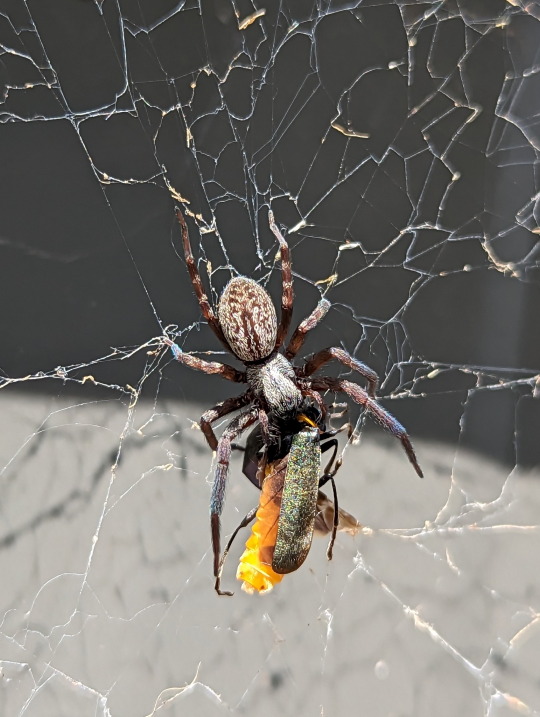

House Spider with Prey
Unidentified, genus Badumna
24/03/23 - NSW, Dapto
#Badumna#unidentified#spiders#spiders tw#arachnophobia#House Spiders#Araneae#Chelicerata#Chelicerates#Arachnida#Arachnids#invertebrates#invertblr#Arthropods#Arthropoda#bugblr#bugs#bug#bugs tw
46 notes
·
View notes
Text

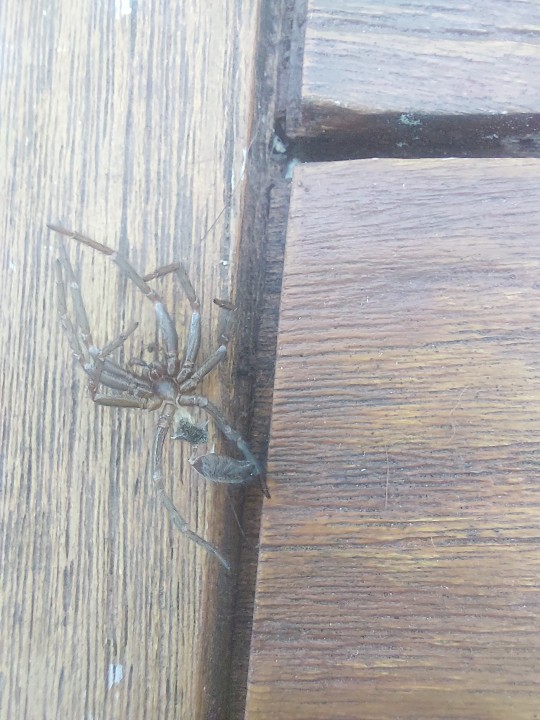
A molt I found! I believe from a badumna of some kind, we get a lot of them hanging around the house around here, but it's special seeing one so well preserved.
0 notes
Photo

@mandelbrotfrancis submitted: I found this funky fellow by my bed and I'd like to know what type/species of spider they are .:) (North Island, New Zealand)
Looks like either a black or grey house spider in the genus Badumna, I think! But take that with a grain of salt because I am not familiar with New Zealand’s spiders :)
70 notes
·
View notes
Photo

Check out this #spider that lives by our kettle.. we call it the #KettleSpider! 🕷 Probably a #BlackHouseSpider though!! 😉 #wildlife #kitchenwildlife #arachnid #Badumna #Christchurch #NewZealand 🇳🇿 #instawildlife #nature #iphone6 📱 (at Christchurch, New Zealand)
#arachnid#badumna#spider#wildlife#newzealand#christchurch#nature#kitchenwildlife#instawildlife#iphone6#kettlespider#blackhousespider
6 notes
·
View notes
Photo

¡Qué patrón de telaraña tan inusual e interesante! Este es un patrón típico de las arañas Paramatachia. Otras arañas de la misma familia (Desidae) también hacen telarañas similares, como Badumna y Matachia. Todas se pueden encontrar en Australia/Nueva Zelanda; se supone que la imagen fue tomada en Tasmania.
Crédito: M. Hedin.
19 notes
·
View notes
Note
Hi! I was wondering if you could help me with some spider questions in the fantasy genre. See, I'm trying to write a fantasy book and a group of humans have been cursed to live as abnormally large spiders without their human mind. I want to write the spider behavior somewhat accurately, despite the unrealistic situation (and I'm not sure what kind of spiders or if hybrids is the way to go), but I don't know where to start or what the specific key words are to figure out what I need to know.(1/2)
(2/2) I’ve done some research on it before but was unable to really find what I was looking for (probably also because I’m not sure about the spider type), so I was wondering if you were willing to point me in the right direction with some good, basic websites? (Danish, English or both are fine). Either way, thanks in advance!
Generalizing spider behavior is like generalizing carnivoran behavior! Like, sure, cats and dogs have a lot of behavior in common, but you wouldn’t say their behavior is the same. Just think about it: there are 270 species of carnivorans and all of them - even the close relatives, like wolves and coyotes - have different behavior. Meanwhile there are around 40.000 species of spider!! So you’re right that the reason you can’t find any concrete behavior is probably because you haven’t narrowed down any species to take your inspiration from :)
There are a few things you can generalize about spider behavior:
Spiders, like cats, are both predators and prey (and even then there’s exceptions like Bagheera kiplingi who are mostly vegetarian or Adelocosa anops who don’t really have any predators). Spiders aren’t confident apex predators who laze around, like lions. They have to be on guard at all times, and most prefer to hide when they aren’t actively hunting for food or mates. This may not be relevant to your story though, if your spiders are the size of Shelob!
Spiders’ primary sense is sensing vibrations in the air and ground with fine hairs on their legs and abdomen. Even species that rely heavily on eye-sight (like jumpers) still primarily sense with their hairs. They also detect sounds and smells with hairs on their legs and have no sense of taste in their mouth. Most spiders have really lousy sight and all of them have lousy hearing!
All spiders make web, but they make it for wildly different reasons (even a single species can easily have 5-10 different kinds of web). A few examples of webs include spiral webs, tangle webs, sheet webs, safety lines, sperm webs, egg sacs, gossamer threads, and cocoons. This article gives a really good overview [https://en.wikipedia.org/wiki/Spider_silk] and if you really wanna dig deep, the book “Spider Silk: Evolution and 400 Million Years of Spinning, Waiting, Snagging, and Mating” by Leslie Brunetta and Catherine L. Craig should be really good (though I haven’t personally read it yet).
All spiders (and all animals, honestly) exhibit some kind of social behavior. For some spiders this is overt aggression towards other members of their species. For others it’s tolerance, or even a preference for being social! The key is that they all react to and interact with members of their own species.
Some species I suggest looking into (aka some of my favorites, I’m very biased):
Long-bodied cellar spider (Pholcus phalangioides) - A common guest in bathrooms around the world. They may not look like much, but they have some of the most interesting social behavior imho! There’s a bit of conflicting information floating around, which is par for the course for any invertebrate, but to generalize: They’re semi-social, as the slings and juveniles will often cooperate when building webs and catching prey, and they’re web-pirates who’ll steal other webs and eat the former inhabitants. Young spiders are known to eat communally, and older spiders are known to live close to and tolerate each other. The female mixes sperm from several males, which means that all males have sired some of her offspring and thus won’t want to kill it because they might kill their own. The female protects her eggs and babies for weeks until the juveniles can survive on their own and disperse. This is a fairly common level of sociality that you’ll also see in a lot of other genera, including Metepiera, Cyrtophora, and Badumna. Can you tell I love my bathroom spiders?
Socotra Island blue baboon (Monocentropus balfouri) - This species is also ‘just’ tolerant of other members of its species, but it’s unique in that it’s a tarantula! Individuals from different egg sacs can sometimes attack each other, but if they’re raised together and have enough food they won’t mind each other. The females will defend and feed their offspring until they’ve molted a few times, so they’re also good mothers!
Social wall spider (Oecobius civitas) - This one’s probably the most unique (and the one with the scarcest information online). These spiders’ webs are connected, and can hold up to 200 spiders per 100 square inches. If one spider is disturbed it’ll dart out of its little web burrow and try to find another hiding place, and if no hiding place is available it’ll run into another spider’s burrow. The spider in this burrow will then flee and try to find a new hiding place, which can lead to tens of spiders running around for several seconds until they’ve all found new hiding places. Another thing these spiders do is having a shared egg sac in their colony where all the females will deposit their eggs, which are then protected communally by adults and older juveniles. They also hunt communally which lets them take down larger prey, and have been known to regurgitate food to feed spiderlings.
Honorary mention to Agelena consociata, Anelosimus eximius, and Archaearanea wau who might actually be the most social spiders, but whom I’d have to read up on to accurately cover. I’ve already spent much more time on this than I meant to, RIP. The book “The Encyclopedia of Land Invertebrate Behaviour” by Rod and Ken Preston-Mafham covers their behavior.
This paper gives a very quick overview of the social behavior of a bunch of different species: [https://www.academia.edu/2702901/The_evolution_of_social_behavior_in_spiders]
2 notes
·
View notes